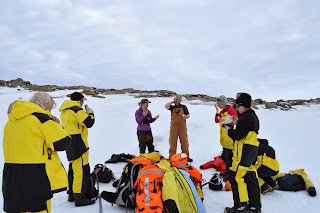SAR rescue training was undertaken last week, in this training we learn to recognise correct anchor points in snow and ice, should a rescue situation arise. The FTO had found a snow drift drop off on the Southern end of Plough island approx 6 k's from the Station, which was suitable for the training exercise, the day was overcast around -2, not bad considering where we are and no wind which was a bonus.
The crew preparing for a big day out on the snow, surprisingly sun screen is essential you get fried from above and the reflection off the snow, it's not uncommon to get sunburn under your in your nostril's.
We travelled out in hags and 2 x quads, the sea ice is starting to break up a bit won't be much longer and no travel will be allowed.
Discussion of what we were about to undertake,
View from the top of the drift
The gear we will be needing for the day, which includes mainline, Belay, snow anchors, rigging ropes various other pieces of equipment needed for a SAR exercise, all packed into back backs which in most cases we would have to carry as most rescue situations would be on foot.
This is a 3 point anchor system in snow which we used for the mainline, (which is the main rescue rope)
Val topping up on lip balm, Stu looking like he is after a gig in a fashion mag, PJ opening a snack bar.
Another 3 point anchor, this time for the Belay line (backup rope for the mainline)
Drop off, this was about 12 meters to the bottom
Sarah was the attendant and the doc was the patient, this was undertaken to give the Doc an idea of what the patient would be going through in a rescue situation.
The patient was bought up both vertically and horizontally to give us an idea of which would be suitable.
Mainline team under instruction from the FTO, re rigging the system to a 9:1 for the lift, not normally used in this situation, more to show the differences in ratios
View of drop off, back across to the mainland.

































